Smart Vegetable Garden Layouts for Small Spaces: Maximizing Your Green Thumb in Compact Areas
Ever thought about turning a tiny backyard or balcony into a vegetable garden? Learn how to make the most of your small space. This article will show you how to use smart vegetable garden layout ideas to grow a lot in a little space. You can use even a small patio, courtyard, or plot to grow your own food.
We’ll cover everything from raised bed gardening and container gardening to vertical gardening and small border planting. These innovative methods will help you use your compact area well. This guide is full of useful tips and ideas to help you turn your small outdoor space into a productive vegetable garden. You’ll get to enjoy fresh, homegrown produce all year.
Introduction
Starting your small space vegetable garden is both exciting and rewarding. You can grow a garden even with a small balcony, patio, or backyard. This article will show you how to make the most of your space for a beautiful and productive garden.
Small-space gardening offers many innovative ways to make the most of limited areas. You’ll learn about the best plants and layouts for your garden. This guide will give you the skills and ideas to use your space well.
Get ready to enjoy growing your own food, herbs, and flowers. You’ll also make your outdoor space look better. Let’s start exploring how to create a great vegetable garden in a small space!
Understanding Your Space
Creating a small vegetable garden starts with knowing your space well. Whether it’s a balcony, patio, or backyard, look closely at what you have. This will help you use your very small garden ideas on a budget wisely.
Assessing Available Space
First, measure your outdoor area. This tells you how much space you have. It helps you pick the best vegetable gardening ideas for small spaces. Even tiny areas can become great gardens.
Identifying Sunlight and Shade
Then, check how the sun hits your space. Find out where it shines fully, partly, or not at all. This info helps you choose the right vegetable gardening supplies for your plants.
Soil Quality and Preparation
Good soil is key for a raised bed vegetable gardening for beginners. If your soil is bad, add compost or use a raised bed with good soil. Good soil is vital for your garden to do well.
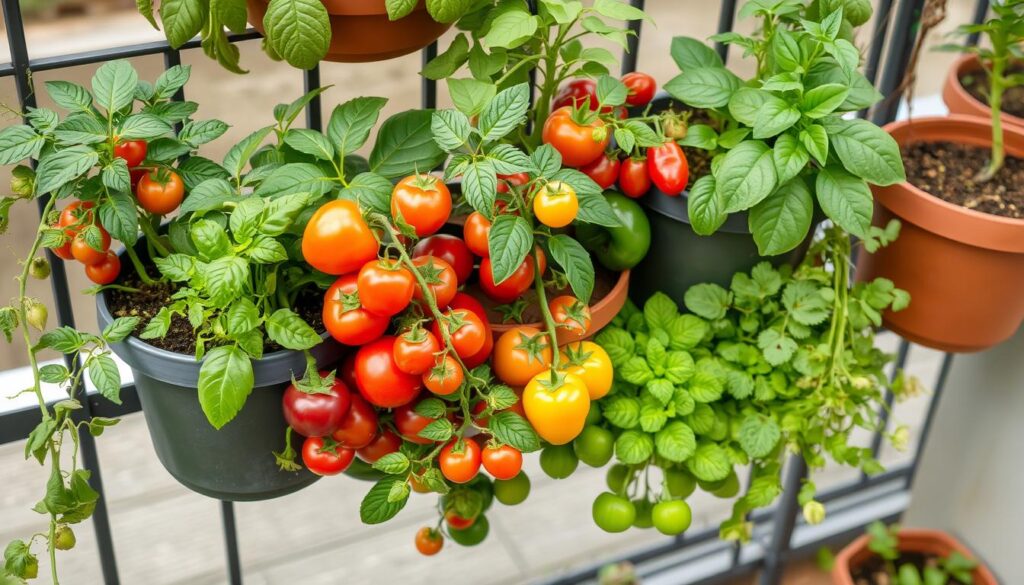
“The secret to a thriving small-space vegetable garden lies in understanding the unique characteristics of your available area.”
Choosing the Right Layout for Your Space
For small-space vegetable gardening, the layout is key. You can use raised beds, containers, or vertical solutions. These options help you make the most of your space and grow a great vegetable garden layout for small spaces.
Raised Bed Gardening
Raised bed vegetable gardening for beginners is great for small areas. It lets you control the soil and plant more densely. Use materials like cedar, hemlock, or corten steel for your raised beds. Fill them with a mix of garden soil and compost for good drainage and early warming.
Container Gardening
If you don’t have much ground space, container gardening is a good choice. You can grow veggies in pots, windowboxes, or hanging baskets. Choose containers with good drainage and use a light, draining potting mix for your small vegetable garden layout.
Vertical Gardening
Using vertical space is smart for very small garden ideas on a budget. Grow plants like cucumbers and tomatoes on trellises or fences. This saves space and reduces pests and diseases by keeping plants off the ground.
Small Border Planting
If you’re short on space but want to garden, try small border plants for landscaping. Use compact veggies like leaf lettuce and parsley between other plants. Or mix food crops with flowers in containers.
By trying out these vegetable garden layout plans and spacing ideas, you can make the most of your small space. Enjoy a big harvest of fresh produce from your garden.
Selecting the Right Plants for Small Spaces
For small-space vegetable gardens, pick plants that are compact and produce a lot. Look for “bush,” “dwarf,” or “patio” types made for containers or small areas. Plants like ‘Micro Tom’ tomatoes, ‘Mascotte’ bush beans, and ‘Katarina’ mini cabbages are great for small spaces. They give you a big harvest without taking up much room.
Compact and High-Yield Varieties
It’s important to choose compact and high-yielding vegetables for small gardens. These plants are made to give a lot of food without needing a lot of space. By picking these, you can have a wide variety of garden vegetables list in tiny spaces.
Companion Planting
Companion planting is a smart way to garden in small spaces. It means growing different plants together to keep pests away, improve soil, and increase food. For example, growing fast plants like lettuce with slow-growing tomatoes makes the most of your space.
Seasonal Planting Strategies
Make the most of each season in a small garden. Use succession planting to follow one crop with another in the same spot. After spring crops are gone, add summer plants like bush beans, zucchini, or cucumbers. This vegetable garden layout for small spaces keeps your garden busy all year.

By picking the right plants, using companion planting, and planting at the right times, you can make the most of your small vegetable gardening ideas for small spaces. This way, you’ll get a big harvest from your garden.
Essential Gardening Supplies for Small Spaces
When you’re working with limited space, having the right vegetable gardening supplies is key for a successful small vegetable garden. Choose compact, space-saving tools to make the most of your area. Tools like mini hand trowels and collapsible garden carts are great for raised bed vegetable gardening for beginners or vegetable gardening ideas for small spaces.
Tools and Equipment
- Mini hand trowel for tight spaces
- Compact pruning shears for precise trimming
- Collapsible garden cart or wagon to transport supplies
- Vertical supports like trellises, cages, or stakes for climbing plants
Soil and Fertilizers
Make sure your small vegetable garden layout has rich soil by adding high-quality compost or organic fertilizer. For container gardening, use a potting mix made for vegetables. Adding compost or slow-release fertilizer often will keep your plants healthy and productive in small spaces.
Watering Systems
Proper watering is key for your vegetable gardening supplies. Choose systems like drip irrigation or soaker hoses to water plants directly and save water. For containers, use self-watering planters or a simple watering schedule to avoid too much or too little water.
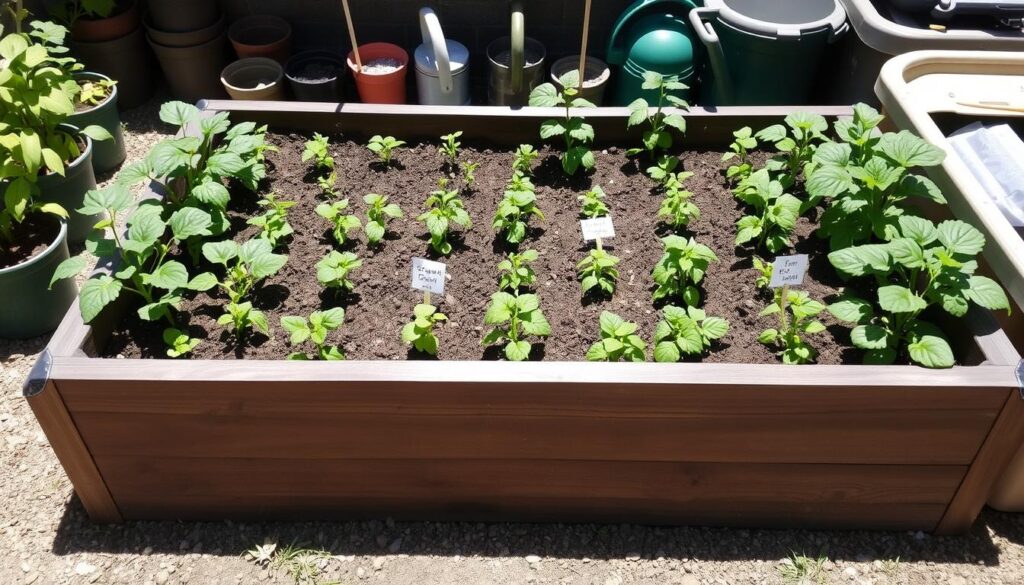
“With the right vegetable gardening supplies and creativity, you can turn even the smallest spaces into a thriving small vegetable garden.”
Budget-Friendly Tips for Small Space Gardening
Gardening in a small space on a tight budget is doable with creativity and resourcefulness. By using DIY projects, upcycling, and finding affordable supplies, you can make your small garden thrive. You won’t have to spend a lot of money.
DIY Garden Projects
Get creative and show off your DIY skills. Use items like plastic containers, wooden pallets, or old gutters to make planters and vertical gardens. These homemade items save money and make your garden stand out.
Upcycling and Repurposing
Try upcycling and repurposing to decorate your small vegetable garden layout. Turn old tires, buckets, or washing machine drums into planters. These upcycled items are good for the planet and add personality to your garden.
Sourcing Affordable Supplies
When setting up your vegetable gardening supplies for a raised bed vegetable gardening for beginners setup, find affordable sources for things like soil, seeds, and seedlings. Look at local garden centers, home improvement stores, or online for sales. Also, check out community seed exchanges or swap programs for cheaper, quality plants.
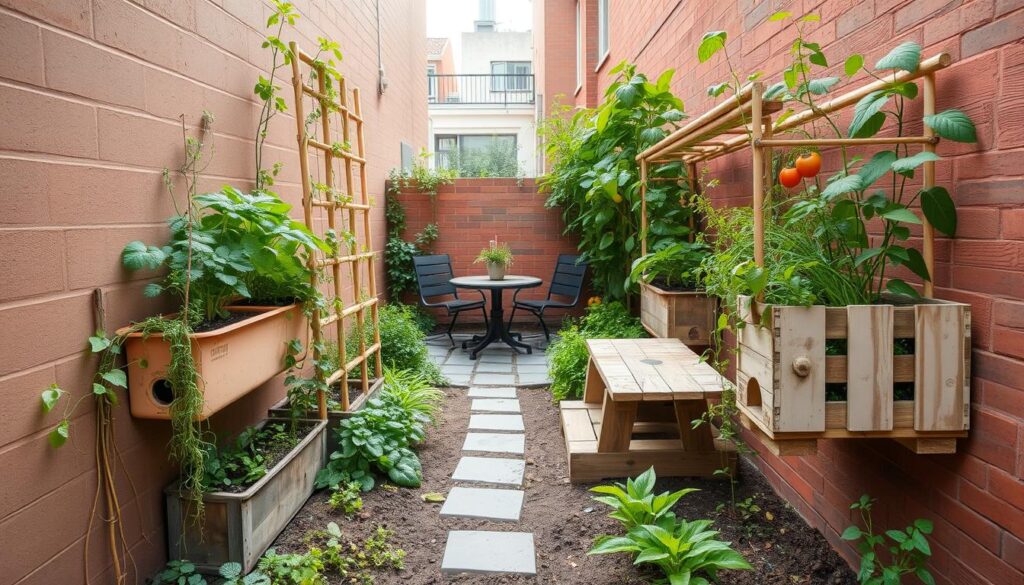
“Embrace the art of upcycling and repurposing to furnish your small vegetable garden layout.”
Vegetable Garden Layout Plans and Spacing
Creating a good layout plan is key for a small vegetable garden. Think about the size and growth of your plants. Place taller plants like tomatoes or pole beans at the back. This lets shorter plants like lettuce or radishes grow well in front.
Creating a Layout Plan
When planning your garden, focus on the right spacing for each plant. Check seed packets or plant tags for spacing advice. This helps avoid crowding, ensures good air flow, and lets your veggies grow well.
Optimal Spacing
- Tomatoes: 24-36 inches between plants, 36-48 inches between rows
- Carrots: 1-2 inches between plants, 12-18 inches between rows
- Lettuce: 8-12 inches between plants, 12-18 inches between rows
- Zucchini: 24-36 inches between plants, 36-48 inches between rows
Example Layouts
Look at example layouts to get ideas for your small garden. You can find plans for raised beds, containers, vertical gardens, and mixed borders. Use these ideas to make a layout that fits your space and goals.
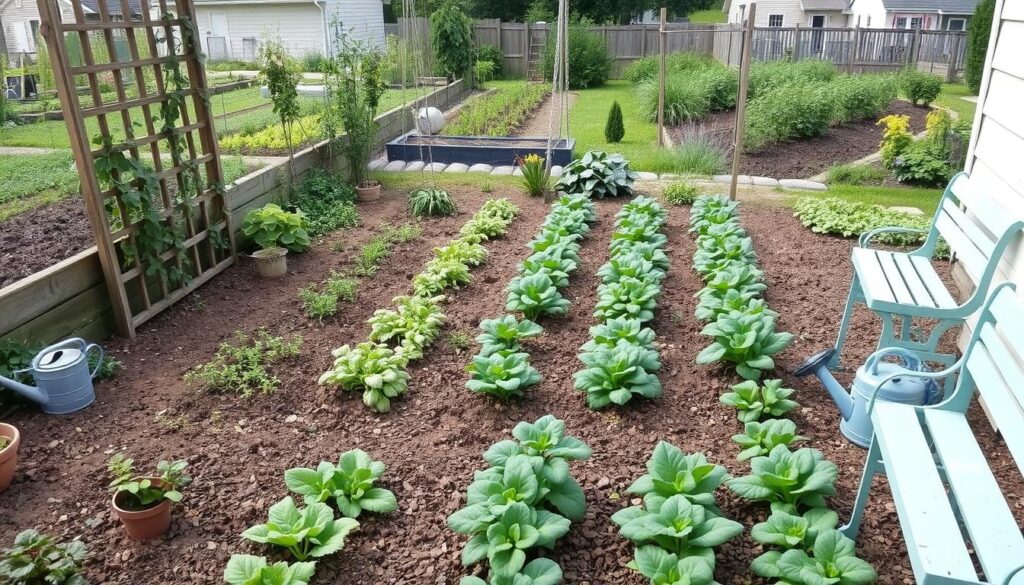
Plan your garden’s layout and spacing well to make the most of your space. This way, you can enjoy a lot of fresh, homegrown produce.
Conclusion
This article has shown you how to make your small outdoor space a great place for vegetable gardening ideas for small spaces. You learned how to pick the right plants and arrange them well. This guide has given you the tools to make the most of your small garden.
Even tiny spaces can produce a lot of vegetables with creativity and hard work. You can use raised beds, containers, or vertical gardening. These methods offer many ways to garden in small areas. Take on the challenge and watch your garden grow in your small outdoor space.
Enjoy your gardening and harvesting! Let your small-space garden give you fresh, healthy food and the happiness of growing your own plants.
FAQ
What are some clever vegetable garden layouts for small spaces?
How can I maximize my yields in a small vegetable garden?
What are the key considerations when planning a small-space vegetable garden?
What are the benefits of raised bed gardening for small spaces?
How can I incorporate vegetables into a small landscape?
What are some budget-friendly tips for small-space vegetable gardening?
How do I create an efficient layout for my small vegetable garden?
Source Links
- Small Vegetable Garden Ideas – https://www.gardengatemagazine.com/articles/vegetables/edible-plant-guide/small-vegetable-garden-ideas/
- 52 small garden ideas – tiny, fabulous designs to copy in your outdoor space – https://www.realhomes.com/design/small-garden-ideas
- Maximizing Small Spaces: Landscape Design Ideas for Compact Gardens – https://www.needforbuild.com/maximizing-small-spaces-landscape-design-ideas-for-compact-gardens/
- 10 Must-Have Blooms for Your 2025 Garden
- The Health Advantages of Gardening You Need to Know
- How to Create a Small Vegetable Garden Layout Plan: A Beginner’s Guide
- DIY Garden Projects for Small Spaces: Upcycling Ideas to Maximize Your Garden
- Watering Techniques for Small Gardens: Ensuring Your Plants Thrive
- Small Border Plants for Landscaping: Adding Beauty and Functionality to Your Garden
- Year-Round Small Space Gardening: Seasonal Planting Tips for Maximum Harvest
- Essential Tools for Small-Space Gardening: What You Really Need
- The Ultimate Guide to Container Vegetables: What to Grow in Small Spaces
- Budget-Friendly Gardening: How to Create a Thriving Garden on a Tight Budget
- How to Optimize Sunlight in Small Gardens: Tips for Better Plant Growth
- DIY Vertical Planters: Creative Ideas for Small Space Gardening
- Companion Planting for Small Vegetable Gardens: Boost Growth and Deter Pests
- Container Gardening Essentials: Choosing the Right Pots, Soil, and Plants
- Vertical Gardening Techniques: Maximizing Your Small Space with Climbers and Vines
- How to Build a Raised Bed Garden in a Small Backyard: Step-by-Step Guide
- The Best Vegetables for Small-Space Gardens: High-Yield Varieties You Need to Grow
- Smart Vegetable Garden Layouts for Small Spaces: Maximizing Your Green Thumb in Compact Areas
- 40. Best Practices for Managing a Sustainable Garden Year-Round
- Building a Wildlife Pond for Biodiversity
- Advanced Techniques in Sustainable Gardening
- How to Create a No-Till Garden
- The Mental Health Benefits of Gardening
- Using Technology to Enhance Sustainable Gardening
- Getting Certified Organic: Steps and Benefits
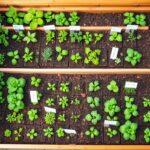
Leave a Reply